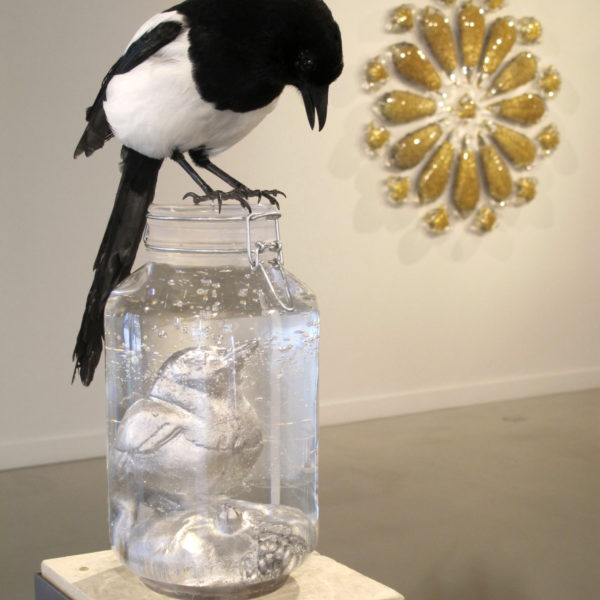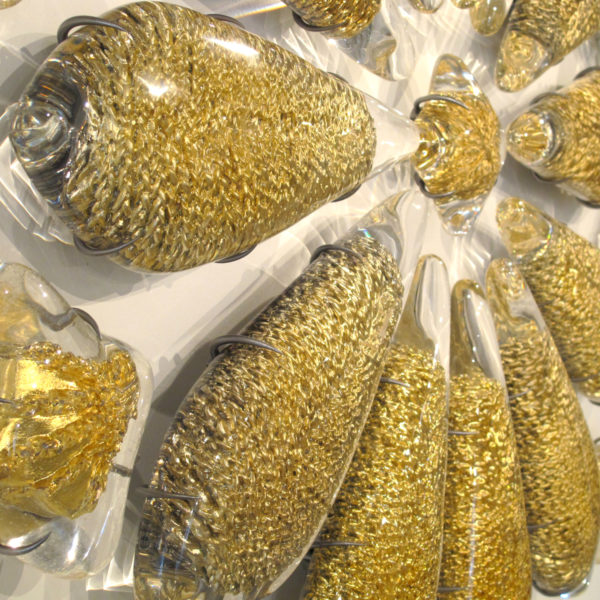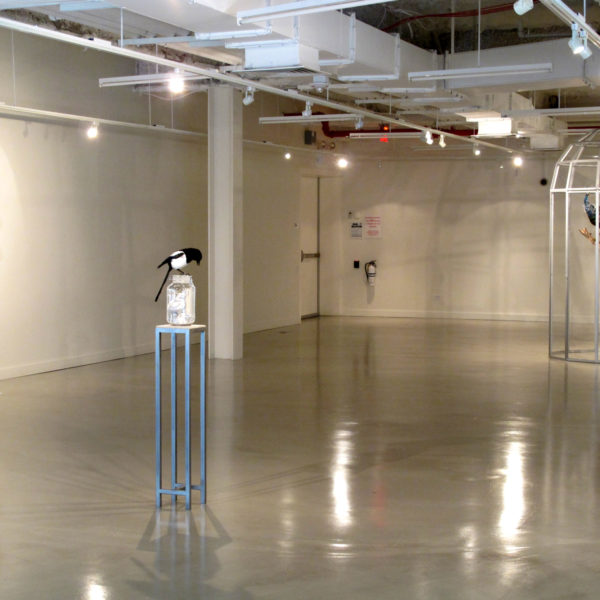The Dominant Sophia
June 11th – July 26th, 2014Exhibitions
Joanna Manousis + The Dominant Sophia
an essay by William Warmus
I am writing this essay about one of my favorite contemporary artists, Joanna Manousis, for her first solo exhibition in New York City, at UrbanGlass in Brooklyn, that is opening this week.
The images attached include details of the rose window inspired installation, composed of multiple parts, that is the centerpiece of the show. Joanna has cast the residual detail of hundreds of kernels of wheat within solid clear crystal segments and has endowed them with the glow and reflectivity of a 24 karat gold mirror.
In her Masters of Fine Art essay, Joanna includes a quote from Jean Baudrillard that is applicable not only to her work, but to much of what we look at in the most advanced outposts of contemporary glass:
In ‘The System of Objects’, French philosopher and cultural theorist Jean Baudrillard states that due to the transparent and reflective properties of glass, it ‘is the most effective conceivable material expression of the fundamental ambiguity of ‘atmosphere’: the fact that it is at once proximity and distance, intimacy and the refusal of intimacy, communication and non-communication’ (41).
Joanna then writes:
"It is the transparency of glass as a solid atmosphere that I find most compelling, and I use its intrinsic material value to create objects of ambiguity that, through positioning and placement, can engage a viewer and project a dialogue."
The precious kernels of wheat remind me of both the gold and glass throne of Tutankhamen and the stained glass window by Gerhard Richter for the Cologne Cathedral. The Richter window is complexly abstract and is meant to challenge the narrative of the accompanying windows in the church.
Joanna's work also plays with narrative, and what I like about her choice of the three objects for this exhibition is that the narrative goes from proximity, the sharp intimate focus of a magpie looking at its own reflection within a distillery jar, then shifts to ambiguity (why are there multiple species of glass succulent cacti seeming to grow from beneath a peacocks feathers?) and finally to a puzzling abstraction (the rose window, with its hundreds of wheat kernels, that with repetition, gilding and woven integration, become a complex abstraction). The entire show creates, in my opinion, a "fundamental ambiguity of atmosphere" where intimacy is suggested and refused, and communication of the narrative itself is interrupted and distanced from the viewer. Glass is the perfect material for conveying this atmosphere.
Let's go back now and virtually walk through the show.
You ought to enter the exhibition of artwork by Joanna Manousis at UrbanGlass in New York City from the left.
You see three objects.
A taxidermy magpie looking into a solid crystal jar that contains the mirrored detail of itself sitting on top of a pomegranate. The magpie is one of the few species of bird that has the gene for self awareness, and is, therefore, a collector who hoards reflective objects in its nests. Perhaps this piece embodies the concept of glass collecting?
A taxidermy peacock residing within a round glass greenhouse that is a reminder of the ones built during the Victorian era to grow exotic species. The bird is adorned with glass succulent cacti that seem to be nurtured by the greenhouse that the bird is 'caged' within. In terms of scale, beauty and concept, the peacock competes for our attention with the rose window nearby.
A shimmering gold installation blossoming on the wall, that looks quite weightless.
And also, the title of the show, "The Dominant Sophia," denoting an all seeing eye of a greater power.
Upon a closer inspection, the installation mounted on the left hand wall of the gallery resembles the rose windows typically found in cathedrals.
The rose window of the Middle Ages has its origin in the oculus of Ancient Rome, for example the Pantheon in Rome: a circular cut out in the ceiling of a structure that connects the floor to the sky, allowing light to flood into the space . There are also obvious associations with a wheel. Many Rose windows have the last judgement as their subject. The Catholic God, in the form of his son Jesus, is frequently shown at the center.
But here is where Joanna parts ways with god, if you will. Her center is an abstraction of grains. And the light comes not from outside, not from the sun, but from the light within the gallery space.
And yet, the move toward abstraction is not unlike the monotheism of the ancient Egyptian pharaoh Akhenaten, whose highly abstract sun god reached out with many golden hands to touch the pharaoh and those around him. And wheat was a staple food in ancient Egypt.
So why not use grains of wheat to represent the beams of the sun, only in this case the beaming and reflecting focuses on us, brings us back to ourselves rather than to god. Perhaps the The Dominant Sophia is a critique of the ego. Instead of imaging one or a few, it encompasses, potentially, everyone and not just one. It denies the intimacy of the self in favor of a vaster program.
We are represented by reflected images so tiny that we seem not to matter very much, rather the entire ensemble is what matters. In that context, we all seem equal, not hierarchical. And even the petals of the rose are treated as equals, as repetitions. It takes the ego out of the self. And notice that the outermost components of the structure show the wheat kernels woven together into a mesh/web/net.
All this speculation may be far out, but it makes me think of a quote from Daniel Patrick Moynihan: “Everyone is entitled to his own opinion but not his own facts.” And the facts are before us: The Dominant Sophia. So go back and check the facts (the images) yourself, tell us what you learn.
William Warmus is a freelance curator and art historian, a Fellow of the Corning Museum of Glass, Board Member at UrbanGlass, and the author of a dozen books and about 100 essays. His next book, "The True History of Glass," is about the art, history, and anthropology of contemporary glass.
About the artist: Joanna Manousis received her BFA from Wolverhampton University in Wolverhampton, England and her MFA from New York State College of Ceramics, Alfred University, in Alfred, New York. Her glass and mixed media sculpture have been exhibited internationally and she has held residencies at The Museum of Arts and Design, NYC, The Corning Museum of Glass, New York and Cité Internationale des Arts, Paris, France. The Dominant Sophia is the first solo presentation of her work in New York City.





